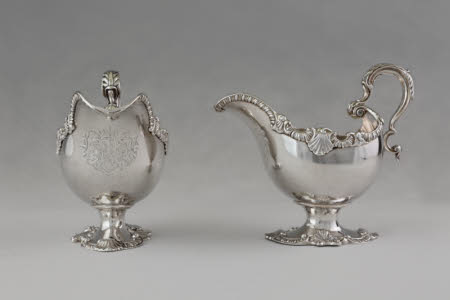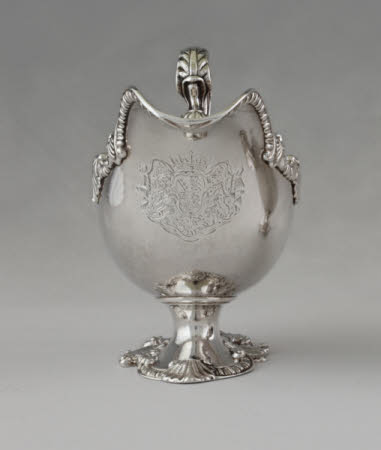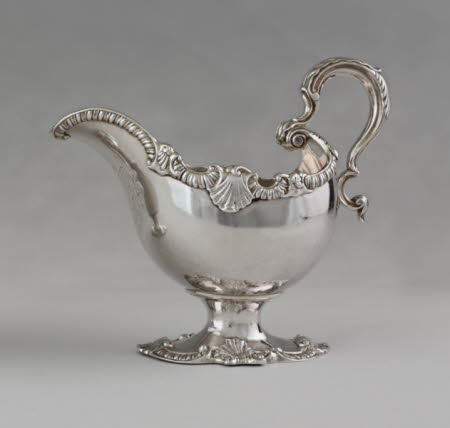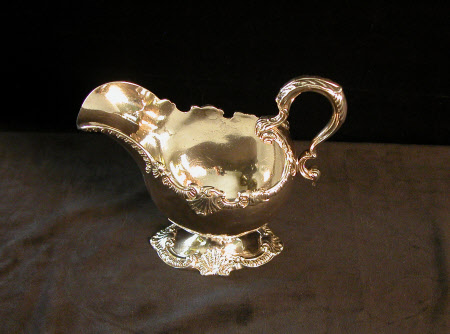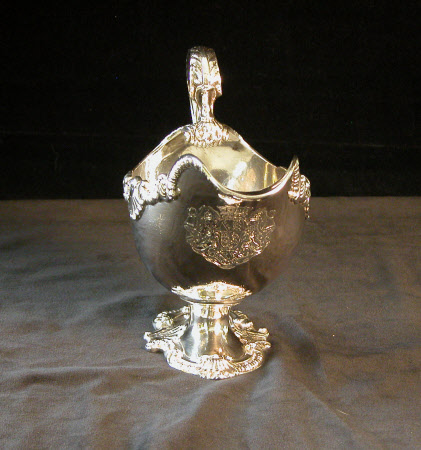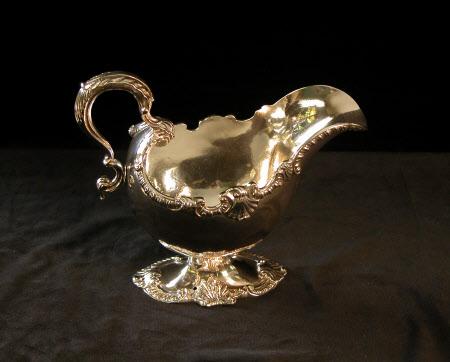Two sauce boats
Daniel Piers (fl.1746-1753)
Category
Silver
Date
1751 - 1752
Materials
Sterling silver
Measurements
17.5 x 20.3 x 10.8 cm
Place of origin
London
Order this imageCollection
Ickworth, Suffolk
NT 852082
Summary
Two sauce boats, sterling silver, by Daniel Piers, London, 1751/2. The raised oval, helmet-shaped body of each boat rests on a shaped oval foot with cast and chased shells, C-scrolls and gadrooning. The same decoration augments the cast and chased rim which rises to a broad pouring lip and an inward curving scroll upon which rests the double-scroll and leaf-capped handle. Heraldry: On the front beneath the lip of each is engraved the quartered shield, supporters and motto of the 2nd Earl of Bristol in an ermine mantling and beneath an earl’s coronet. Hallmarks: Both are fully marked on the underside with maker’s mark ‘DP’ beneath a pellet (Arthur Grimwade, London Goldsmiths 1697-1837, 1990, no. 493), lion passant, date letter ‘q’ and leopard’s head. Scratchweights: ‘23=2 [/] N1’ and ‘23=3’ [/] N2’
Full description
The 1811 plate list [1] reveals that this and the other two types of sauce boat in the collection (NT 852081 & 852122) were each in sets of four, giving a total of twelve available for the dinner table. This was quite a prodigious quantity for the mid eighteenth century, the same as found at Dunham Massey in 1750/54 and two more than in the great Leinster dinner service of 1747.[2] In contrast the decidedly conservative 2nd Duke of Montagu had just four at Montagu House in 1746.[3] The Wickes ledgers and Jewel Office records corroborate a general increase in numbers for the tables of grandees as the century progressed. This is particularly clearly expressed by the case of Henry Bromley, 1st Baron Montfort, of whom Lady Hervey wrote on his unexpected suicide in 1755 that he had ‘a great taste for pleasure and an ample fortune to gratify it’.[4] In February 1743 he turned in eight sauce boats to George Wickes and replaced them with ten and in 1751 the number was upped to twelve.[5] Sauces were critical to fine cuisine in the mid eighteenth century and Vincent La Chapelle in The modern cook, first published in 1733, explains the preparation of over thirty different varieties.[6] They had become increasingly elaborate and extravagant, rumour having it that the Duke of Newcastle’s French chef, Clouet, used a whole ham to make a sauce and twenty-two partridges to produce gravy for a mere brace.[7] William Verral, who had worked with Clouet at Claremont and defended his master against such accusations, included a few more straightforward sauces specifically for sending up in boats in his 1759 publication A complete system of cookery. Amongst these is his (and thus, presumably Clouet’s) version of Sauce Robert: To a ladle of cullis [stock] put a glass of your best white wine, a spoonful of mustard, pepper, salt, shallots and parsley, with plenty of such sorts of herbs as you best approve on; let all stew a minute or two, squeeze in plenty of juice [lemon/orange], and send it up hot in a boat … The reason why the Sauce Robert should not boil long, is, because mustard in boiling grows bitter, and of a nauseous taste.[8] Mono-footed sauceboats were popular from the late 1720s and the elaborate profile of the rim seen on these examples first appeared around 1740.[9] It seems to have been Frederick Kandler who put the elements together with shells and gadrooning, as exhibited on sauce boats by him of 1744 (fig. 89),[10] and Christopher Hartop has identified that the inspiration is likely to have come from a design published in Nuremburg c.1740.[11] Given Kandler’s German origins, close connection to the Meissen porcelain manufactory and extraordinarily sculptural oeuvre he is certainly the most plausible candidate to have made the introduction. As Daniel Piers was supplying Kandler he would no doubt have had access to his designs, or would even have been instructed to follow them, but he does not appear to have been using the same moulds as employed in 1744. His handling of the model is, if anything, rather superior to that of its originator with bolder detail, a more upright form and better proportioned handles. All four of this set of sauce boats survive but only two passed to the National Trust in 1956. James Rothwell, Decorative Arts Curator February 2021 [Adapted from James Rothwell, Silver for Entertaining: The Ickworth Collection, London 2017, cat. 30, p. 109.] Notes: [1] Suffolk Record Office, 941/75/1, list of plate belonging to the 5th Earl and 1st Marquess of Bristol, 1811-40. [2] James Lomax and James Rothwell, Country House Silver from Dunham Massey, 2006, pp. 53 & 167, and Elaine Barr, George Wickes, 1980, p. 198. [3] Tessa Murdoch, Noble Households: Eighteenth Century Inventories of Great English Houses, 2006, p. 109. [4] J. W. Croker (ed.), Letters of Mary Lepel, Lady Hervey, 1821, pp. 206-7. [5] National Art Library, Garrard Ledgers, VAM 2 1740-8, f. 86 and VAM 5 1750-4, f. 12. [6] Vincent La Chapelle, The Modern Cook, 1733, pp. 94-104. [7] Barbara Ketcham Wheaton, Savoring the Past, 1983, pp. 166 and 204-5. [8] William Verral, A complete system of cookery, 1759, pp. xxx-i and 233-4. [9] See for instance the pair by David Willaume II, 1738, sold at Christie’s, 14 December 1966, lot 72. [10] Christie’s, 21 November 1973, lot 70. [11] Christopher Hartop 1996, The Hugueont Legacy: English Silver 1680-1760, cat. 42, pp. 208-11.
Provenance
George Hervey, 2nd Earl of Bristol (1721-75); by descent to the 4th Marquess of Bristol (1863-1951); accepted by the Treasury in lieu of death duties in 1956 and transferred to the National Trust.
Credit line
Ickworth, the Bristol Collection (National Trust)
Makers and roles
Daniel Piers (fl.1746-1753), goldsmith
